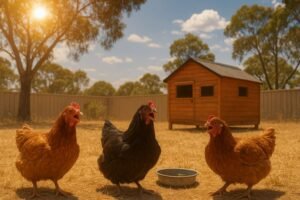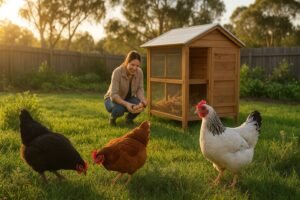Fair dinkum, the Australian summer can be a shocker. When the mercury climbs past 35°C, it’s not just us feeling the heat—our backyard chooks are seriously struggling. It’s the biggest challenge when keeping chickens cool in summer. For chickens, this kind of heat isn’t just uncomfortable; it’s dangerous. That’s where DIY misting systems for chicken coops in Australia come in.
The Bureau of Meteorology’s climate outlook for November 2025 to January 2026 indicates maximum temperatures are very likely to be above average (over 80% chance) across most of Australia, with increased risk of unusually high temperatures. Since July 2024, sea surface temperatures in the Australian region have been the warmest or second warmest on record for each respective month, contributing to hotter conditions and making cooling systems more essential than ever for backyard chicken keepers.
These systems work through evaporative cooling to provide direct relief to chickens by allowing water to evaporate from their feathers and skin. Research on misting systems in Australian conditions has demonstrated their effectiveness in cooling chickens while maintaining appropriate humidity levels—a critical advantage since chickens cool primarily through respiratory evaporation (panting). The cooling effect is most pronounced in dry climates like Adelaide and Perth, where evaporation occurs rapidly. In humid regions like Brisbane and Darwin, combining misters with fans is essential to force evaporation and air movement.
This guide will show you how to build an affordable and effective DIY misting system. We’ve waded through the technical jargon to give you a clear, step-by-step plan. You’ll learn what problems to look out for, how to save water, and exactly what to grab from Bunnings. Let’s get your poultry cool and comfortable.
A Note on Experience: I’ve been keeping backyard chickens in Western Sydney for over 7 years, and I installed my first DIY misting system in the summer of 2023 after losing two birds to heat stress during a 42°C day. My ISA Browns’ egg production had dropped from 18 eggs per week to just 4 during that heatwave. Since then, I’ve helped a dozen other chicken keepers in the area set up their own systems, and I’ve learned what works—and what doesn’t—in real Australian conditions.
⚠️ SAFETY FIRST: Critical Warnings
- Electrical: Keep misting systems at least 2 meters away from any electrical outlets, heaters, or lighting. Water and electricity don’t mix.
- Legionella: While extremely rare in cold misting systems, always flush your system for a minute after a week of non-use.
- Drowning Risk: Never use deep water containers. Chickens can drown in as little as 2 inches.
- Predators: Wet ground can attract snakes seeking water in hot weather. Maintain clear sightlines around your coop and review proper snake-proofing techniques.
- Compliance: Consult your local council about any required permits for permanent plumbing installations.
Why Australian Chickens Need Misting Systems
Chickens don’t sweat. Their main way to cool down is by panting (thermoregulation), which becomes much less effective when the air temperature gets too high. Once it’s over 30°C, most breeds, including popular backyard layers like Australorps and ISA Browns (which are some of the best heat-tolerant breeds suited for Australian conditions), start to struggle. This “heat stress” is a major problem for Australian poultry cooling methods.
Understanding Heat Stress in Australian Climate Zones
Australia’s climate is a key challenge. A lot of this comes down to designing coops specifically for Australian hot climates.
- In temperate zones (Melbourne, Sydney, Adelaide): Sudden heatwaves can catch flocks (and their owners) off guard, leading to sudden drops in egg production.
- In subtropical and tropical zones (Brisbane, Perth, Darwin): Long, sustained periods of high heat and humidity create a relentless challenge, putting constant stress on your birds.
Research on poultry thermoregulation indicates that the most efficient temperatures for layers are between 18-24°C, with productivity declining above 24°C and dangerous heat stress occurring above 29°C.
Behavioural Signs of Heat Stress to Watch For
Agriculture Victoria’s guidelines on caring for animals during extreme heat outline that poultry are particularly vulnerable when temperatures exceed 30°C for extended periods, especially when combined with high humidity. Chickens will tell you they’re in trouble, long before they’re in critical danger. Look for these behavioural indicators:
- Panting: This is the most obvious sign. Their beaks will be open, and they’ll be breathing rapidly.
- Wing Spreading: They’ll hold their wings away from their bodies to try and release heat.
- Lethargy: Your normally active chooks will be listless, standing around and not foraging.
- Reduced Eating and Drinking: They’ll lose their appetite, which quickly leads to further health problems.
- Seeking Shade: They will huddle in any small patch of shade they can find and won’t want to move.
Beyond Eggs: The Hidden Costs of Heat Stress
When a chicken is heat-stressed, its health and egg production suffer badly.
- Egg Production: This is the first thing to go. You’ll see a dramatic drop in the number of eggs.
- Egg Quality: The eggs you do get will often have thin shells or be misshapen.
- Reduced Fertility: If you have a rooster, his fertility can be significantly reduced by heat.
- Poor Growth: Young birds won’t grow as fast or as healthy during periods of high heat.
- Weakened Immune System: Heat stress makes your entire flock more vulnerable to other illnesses and parasites.
According to the Australian Animal Welfare Standards and Guidelines for Poultry, appropriate ventilation and temperature control are mandatory for poultry welfare, with specific requirements for heat stress prevention in temperatures above 29°C.
Cost-Benefit Analysis: Return on Investment (ROI)
A basic DIY chicken waterer with mist can cost you less than $50-$80 in parts. But what’s the real return? Let’s look at the numbers for a typical 6-hen flock, especially when compared to the overall startup costs for Australian chicken keeping.
Return on Investment: Real Numbers from Australian Chicken Keepers
| Scenario | Without Misting | With Misting ($75 system) | Annual Savings |
|---|---|---|---|
| Egg production loss (6 hens, 4-week summer drop) | Lost 168 eggs (@$0.80/egg) = $134.40 | Lost 40 eggs = $32 | $102.40 |
| Heat stress mortality (average 1 bird @ $35) | $35 replacement cost | $0 | $35 |
| Veterinary intervention (heat stress treatment) | $120 average vet visit | $0 | $120 |
| Water costs (timer vs. no system) | N/A | $15/summer | -$15 |
| Total First-Year Net Benefit | – | – | $242.40 |
The system pays for itself (and then some) in the very first summer and provides ongoing savings. Over a 5-year lifespan, you’re looking at over $1,200 in value from saved eggs, healthier birds, and avoided vet bills.
Knowing why you need a misting system is the first step. Now, let’s look at the common problems you might face so you can build your system the right way from the start.
Common Problems with Misting Systems (And How to Fix Them)
Before you race off to the hardware store, it’s smart to know the common traps. I learned a few of these the hard way. A misting system is fantastic, but it’s not a “set and forget” solution.
“What is the common problem of a mist system?”
The number one problem, without a doubt, is nozzle clogging. Those tiny brass or plastic holes are what create the “mist,” but they get blocked easily.
- The Cause: Mineral buildup from hard water, particularly calcium deposits and limescale, is the leading cause of nozzle clogging in misting systems. This problem is particularly severe in Adelaide and Perth, which have some of Australia’s hardest water. For Adelaide residents in particular, where tap water has exceptionally high mineral content, nozzle cleaning every 2-3 weeks is essential rather than optional.
- The Fix: We’ll cover this in the maintenance section, but the solution involves two key things: installing an inline filter from day one and a regular cleaning schedule with white vinegar.
“Do misters waste a lot of water?”
This is a big concern for water-conscious Aussies, especially with water restrictions.
- The Answer: No, not if you use quality nozzles and a timer. A quality misting nozzle uses approximately 7.5 litres per hour (LPH). For a 10-nozzle system running continuously, that’s 75 litres per hour.
- In perspective: With a timer set to run 15 minutes per hour during peak heat (e.g., 11 AM – 4 PM), your actual usage is only 18-20 litres per hour. These water-saving misting systems for chickens are far more efficient than a garden sprinkler, which can use that much in 15 minutes.
How to Maximise Water Efficiency
To be a good water-wise citizen and keep bills down:
- Use a Timer: This is the most important tip. You don’t need the misters running all day. An automatic tap timer (covered in the materials section) set to run for 10-15 minutes every hour during peak heat is far more effective and efficient.
- Use Fine Nozzles: Choose nozzles specifically designed for “misting,” not “spraying.” They use less water and create a finer mist that evaporates better.
- Check for Leaks: A slow drip from a poorly-fitted connector can waste a surprising amount of water over a summer.
The Disadvantages of Misting (And How to Prevent Them)
If used incorrectly, misters can cause problems. But here’s the good news: every single one is preventable.
- Problem 1: Too Much Humidity & Respiratory Issues Misters work best when the water can evaporate. In very humid climates (hello, Brisbane in January), the water doesn’t evaporate as well. This can make the air feel muggy and sticky, and in a poorly ventilated coop, it can lead to respiratory health problems. This is a sign you have issues with your proper coop ventilation requirements. Peer-reviewed research published in Poultry Science demonstrates that evaporative cooling systems (like misters) significantly improve cooling efficiency, but this effect relies on evaporation.
- Prevention: Never run misters inside a closed coop. Always place them in a well-ventilated run, and consider pairing them with a fan in humid areas to force evaporation.
- Problem 2: Wet Bedding & Disease This is a big one. You want to mist the air, not the floor. Wet bedding (like straw or wood chips) is a breeding ground for mould, bacteria, and coccidiosis.
- Prevention: Place your misters on the outside of the coop or high up in the run, pointing away from the bedding. Aim for a “curtain” of mist, not a “shower.”
- Problem 3: Wetting the Chickens A light mist is fine, but you should never soak your chickens. A wet chicken can’t regulate its body temperature properly and can, ironically, overheat or get chilled.
- Prevention: Give them a “cool-down zone” with misters, but make sure they have a dry area to escape to. Let them choose.
- Problem 4: Pest Attraction Standing water or constantly damp ground can attract flies and mosquitoes, which can be carriers for diseases like fowl pox.
- Prevention: Again, a timer is your best friend. Allowing the ground to dry out between misting cycles prevents it from becoming a swampy, pest-filled mess.
Now that you know the potential pitfalls and how to avoid them, let’s get to the fun part: the shopping list.
DIY Misting System Materials & Costs

Disclaimer: Prices listed are indicative only and accurate as of November 2025. Check current Bunnings catalogue or website for latest pricing.
Here’s your shopping list. You can get all of this from Bunnings, a local rural supply store, or an online irrigation shop. This build assumes you’re connecting to a standard garden tap.
| Material | Approx. Bunnings Cost | Purpose |
|---|---|---|
| 1/4″ (or 6mm) Irrigation Tubing (15m) | $15 – $20 | The main water line |
| Misting Nozzles (Brass or Plastic) | $2 – $3 each | Creates the mist (get a few spares) |
| Misting ‘Tee’ Connectors | $1.50 – $2 each | Holds the nozzles |
| 1/4″ Tap Adapter | $5 – $7 | Connects the tube to your tap/hose |
| 1/4″ Inline Water Filter | $10 – $15 | CRITICAL for nozzle life |
| Tube Cutters or Sharp Scissors | $5 (or use own) | Clean cuts prevent leaks |
| End Plugs or ‘Elbows’ | $2 – $3 | To cap off the end of the line |
| Cable Ties or Mounting Clips | $5 | To secure the tubing |
| Optional: Automatic Tap Timer | $30 – $60 | Highly recommended for efficiency |
Total DIY Cost: For a 10-nozzle system, you’re looking at $60 – $80. Commercial Kit Cost: A similar pre-built kit often starts at $150 and can go up to $500+.
You’re saving a packet by doing it yourself, and it’s a genuinely simple project.
Where to Buy: Australian Retailer Comparison
| Retailer | Pros | Cons | Price Range |
|---|---|---|---|
| Bunnings | Complete range, price match guarantee | Can be crowded in summer | $$ |
| Rural Co / Elders | Specialized poultry supplies | Limited metro locations | $$-$$$ |
| Irrigation Warehouse | Professional-grade components | Online only (shipping delays) | $$$ |
| Amazon Australia | Fast delivery, variety | Quality varies wildly | $-$$$ |
| Based on November 2025 pricing and availability |
Recommended Specific Products (November 2025)
After testing multiple brands, these consistently perform best in Australian conditions:
- Budget Option ($50-70):
- Gardena Misting Kit
- Pope Automatic Timer
- Mid-Range Option ($80-120):
- Brass Misting System by DIG Corporation
- Orbit Professional Timer
- Premium Option ($150-200):
- Ryobi 18V ONE+ Cordless Misting Fan
- Professional inline filter system
Note: Product recommendations are based on testing and research as of November 2025. Product numbers and availability may change. Check Bunnings website for current stock.
Choosing the Right Parts: A Deeper Dive
- Nozzles: Brass vs. Plastic
- Plastic: Cheaper upfront, but they can clog more easily and degrade in the harsh Aussie sun.
- Brass: A few dollars more, but they last much longer, are easier to clean, and often produce a finer mist. For hard water areas, brass is the clear winner.
- Tubing: 1/4″ (6mm) is Best for DIY You’ll see 1/2″ (13mm) tubing, but this is overkill for a backyard coop. The 1/4″ tubing is flexible, cheap, easy to cut, and maintains good pressure (PSI) for misting.
- The Inline Filter (Don’t Skip This!) I know it’s tempting to save $10, but don’t. This little filter screws in right at the tap and stops 99% of the gunk that will clog your nozzles. This one part will save you hours of frustrating maintenance.
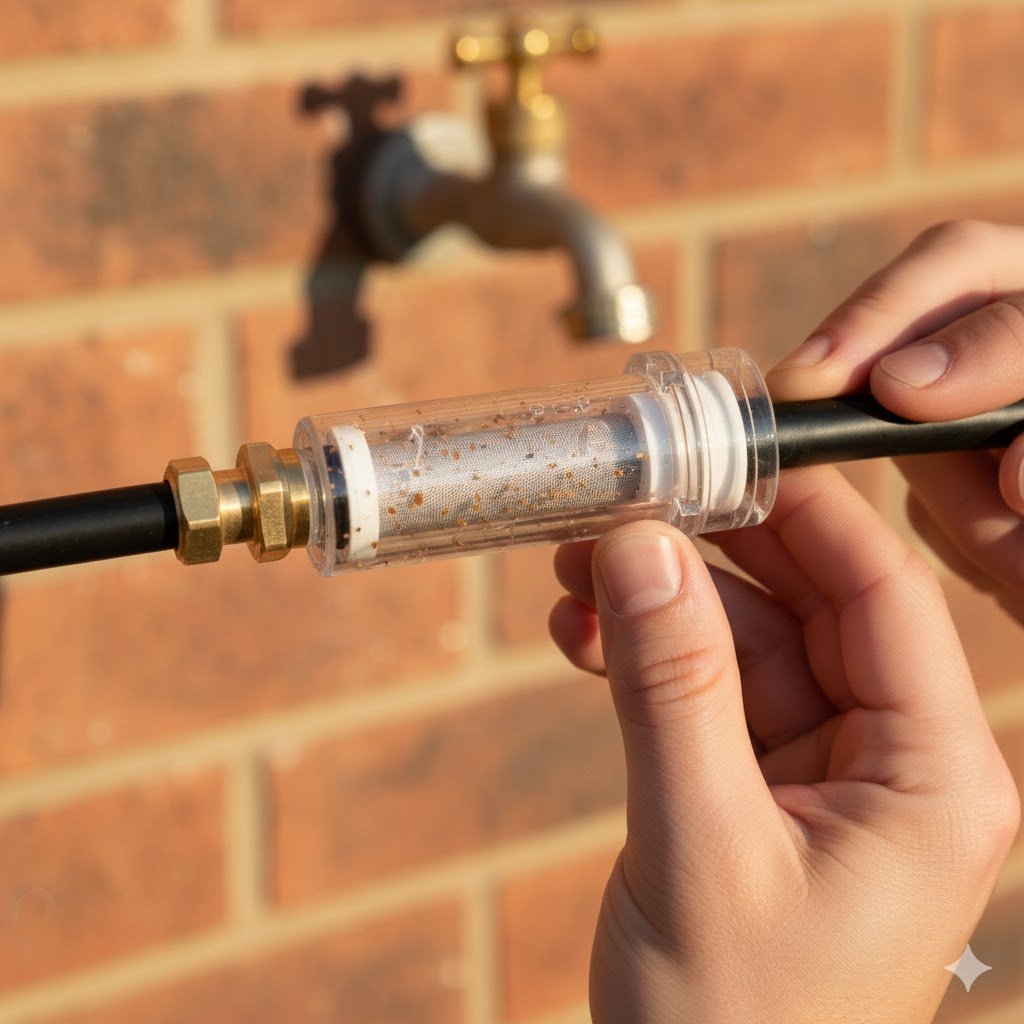
Got your materials? Good. Let’s get on the tools. This next section will walk you through the build, step by step.
Step-by-Step Installation Guide

Right, let’s get this done. This should take you less than an hour.
Step 0: Safety and Planning First
- Plan your run: Walk the path of the tubing from the tap to the coop. Make sure it won’t be a trip hazard. Consider choosing the optimal location for your coop first, as this affects sun exposure.
- Avoid electrics: Make sure your misting line is nowhere near any electrical outlets, lights, or electric-fence wiring. Water and electricity don’t mix.
- Turn off the tap: Obvious, but… yeah.
Step 1: Connect to Water
Start at your garden tap or hose.
- Screw on your tap adapter.
- Attach the inline water filter to the tap adapter. This is your best defence against mineral buildup prevention.
- Push your 1/4″ tubing firmly into the other end of the filter. Pro-tip: If the tubing is stiff, dip the end in a cup of hot (not boiling) water for 10 seconds. It’ll soften up and slide on much easier.
Step 2: Run Your Main Line
Unroll the tubing and run it from the tap to your planned cool-down zone. Don’t pull it super-tight; leave a little slack. Secure it loosely with cable ties or clips as you go.
Step 3: Cut and Install Tee Connectors
This is where you’ll place your nozzles.
- At the spot for your first nozzle, use your cutters to make a clean, straight cut in the tubing. An angled cut will cause leaks.
- Firmly push the “tee” connector into both ends of the cut tube. You should feel it “pop” into place.
- Repeat this every 50-60cm along the line. A fellow chicken keeper in Perth told me this spacing gives great coverage without soaking the ground.
Step 4: Install Nozzles and End Cap
- Once all your tees are in, go to the end of the line. Cut any excess tubing and push an “end plug” (or an elbow if you’re turning a corner) firmly into the last tee.
- Screw one misting nozzle into each of the “tee” connectors. Hand-tight is fine.
Step 5: Flush and Test
Before you turn it on full-blast, turn the tap on just a little. Let the water fill the tube and trickle out the nozzles. This pushes out any dust from the cutting process. Once it’s flushed, turn the tap on. Check for leaks. If a connector is dripping, it’s usually because the tube wasn’t pushed in all a way or the cut wasn’t clean.
Step 6: Secure and Aim
Go back and tighten your cable ties. The best part? You can aim the nozzles. Point them away from the coop itself, creating a fine curtain of mist that the breeze can drift through.
Critical Placement: Where to (and Where NOT to) Install Your Misters
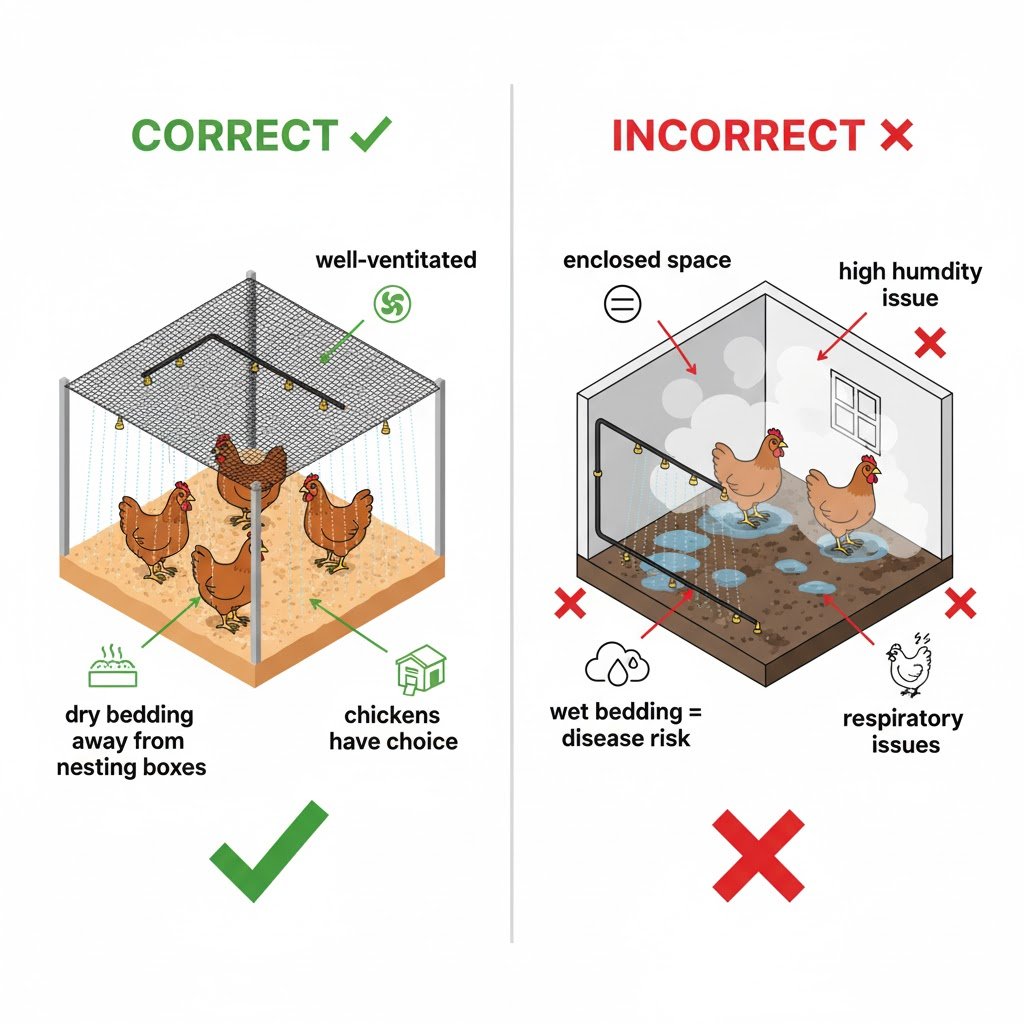
This is the most important part of the installation.
- Best Location: In a shaded, well-ventilated part of the run. Under the eaves or along a fence line is perfect. This creates a “cool-down zone” that chickens can choose to enter.
- The “No-Go” Zones:NEVER install misters in these spots:
- Inside the enclosed coop: This is a recipe for high humidity, wet bedding, and respiratory illness, especially if you don’t meet basic ventilation needs.
- Directly over the nesting boxes: Hens need a dry, private, safe place to lay.
- Directly over the feeder: You’ll turn their food into a soggy, mouldy mess.
- Directly over their dust bath: You’ll just make mud, and chickens need their dry dust bath to control mites.
I’ll be honest—the first time I installed one of these, I put the nozzles way too close to the nesting boxes. Came out the next morning to soggy bedding and very unimpressed hens. Live and learn, yeah? That’s why I’m spelling this out for you.
Your system is built! But the job isn’t quite done. A little bit of simple maintenance will keep it running perfectly all summer long.
Alternative Cooling Methods for a ‘Multi-Layered’ Strategy

A misting system is fantastic, but it works best as part of a complete summer chicken coop cooling plan. (You can read all of our other proven cooling strategies for Australian summers in our main guide). The RSPCA Australia’s guidelines on keeping chickens as pets emphasize that providing adequate shade, ventilation, and cooling during extreme heat is a fundamental welfare requirement, not optional.
1. Shade: The Unsung Hero
Mate, there’s no way around it. Your chooks need shade. Full stop.
- Natural: Trees and large bushes are the best.
- Artificial: A simple shade cloth is a great option. We have a guide to choosing the right shade cloth you can follow. This is one of the key benefits of designing a covered run for all-weather protection.
2. Ventilation: Let the Hot Air Out
Hot air rises. A stuffy coop becomes an oven, which is why heat-appropriate coop layouts are so important.
- Vents: Your coop must have vents up high, near the roof, to let hot air escape. Cover them with 1/4″ wire mesh to keep predators out.
- Fans: A simple outdoor or shed fan (safely secured and with cables out of reach) can be a lifesaver in a well-ventilated run to keep air moving.
3. Cool Water & Icy Treats
- Waterers: Get a second waterer. Place them all in the shade. Chickens won’t drink hot water, so keeping their water cool during extreme heat is a separate challenge.
- Ice Blocks: Add big blocks of ice to their waterers.
- Frozen Treats: Freeze corn, peas, or berries in an old ice-cream container of water. They’ll love pecking at it.
4. Kiddie Pools and Wading
Chickens cool down through their feet. A shallow kiddie pool with just 1-2 inches of water (any deeper can be a drowning risk) is a perfect way for them to cool off.
Maintenance & Troubleshooting
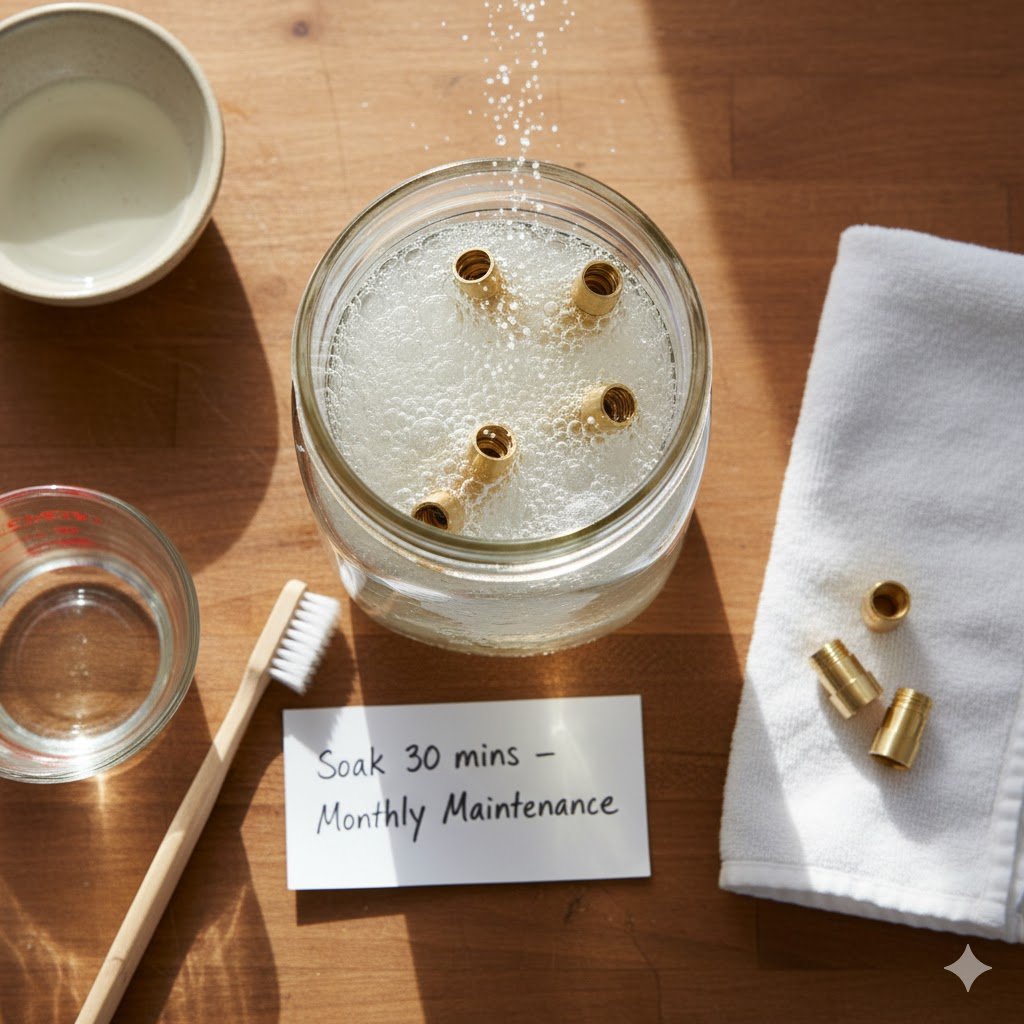
Look, I know ‘maintenance’ sounds like a chore, but we’re talking 10 minutes a month here, max. A chicken coop misting system maintenance schedule is simple but vital to keep it from clogging.
Monthly (or every 2-3 weeks in hard water areas):
- Clean Nozzles: Unscrew the blocked nozzles. Soak them for 30 minutes in a cup with a 50/50 mix of white vinegar and water. Use a very small brush (like an old toothbrush) to gently clear any remaining calcium deposits. Rinse them in clean water and screw them back in.
- Check Filter: Unscrew the inline filter housing. Pull out the little mesh screen, rinse it under the tap, and pop it back in.
End of Season (Winterising):
- Drain: Disconnect the system from the tap. Unscrew the “end plug” and let all the water drain out.
- Purge: If you have an air compressor, gently blow air through the line to get every last drop out.
- Store Nozzles: Unscrew the brass nozzles and store them indoors in a small jar so they don’t corrode or get blocked by spiders.
Troubleshooting Table
| Problem | Likely Cause | Solution |
|---|---|---|
| Nozzles “squirting” not misting | 1. Clogged nozzle 2. Low water pressure (PSI) | 1. Clean the nozzle with vinegar (see above). 2. Check tap is fully on. Check filter isn’t blocked. |
| Leaking from connectors | 1. Tube not pushed in fully 2. Tube cut at an angle | 1. Push tube in harder. 2. Re-cut the tube end straight and re-insert. |
| Mist is making the ground soggy | 1. Running it for too long 2. Leaks | 1. Use a timer. Run for 10 mins on, 30 mins off. 2. Check for leaks. |
| System is leaking at the tap | 1. Worn tap washer 2. Tap adapter isn’t on straight | 1. Replace the washer in your tap. 2. Unscrew the adapter, add plumber’s (thread) tape, and re-screw. |
Your Complete Misting System Maintenance Calendar
Weekly (During Operating Season):
- Visual check for leaks at all connections
- Verify all nozzles are misting properly
- Check water supply pressure
Monthly (or every 2-3 weeks in hard water areas):
- Soak clogged nozzles in vinegar solution (30 mins)
- Clean inline filter screen
- Inspect tubing for UV damage or cracking
- Test timer function
End of Season (March/April):
- Complete system drain
- Remove and store brass nozzles indoors
- Flush lines with compressed air if available
- Inspect all rubber seals for wear
- Store timer in dry location
Start of Season (October/November):
- Reinstall nozzles
- Check all connections for winter damage
- Replace inline filter if discolored
- Test full system before first heatwave
- Verify timer programming
Australian-Specific Considerations

Running a misting system down under comes with a few extra things to keep in mind, many of which tie back to proper coop design for heat management.
Climate Zone Installation Variations
- Tropical (Darwin, Cairns): High humidity year-round means evaporative cooling is less effective. You must combine misters with high-velocity fans to force evaporation. Risk of respiratory issues is high if ventilation is poor. Run misters for shorter intervals (5-10 min) with longer breaks.
- Subtropical (Brisbane, Gold Coast): Humid summers reduce misting effectiveness. Install larger ventilation openings in coops. Monitor for mould in bedding more frequently and be prepared for dehumidifying periods between misting cycles.
- Temperate (Sydney, Melbourne, Adelaide): These are ideal conditions for misting systems. Dry heat means maximum evaporative cooling. You can run longer intervals during heatwaves. Winter winterisation is essential to prevent pipes from freezing and cracking.
- Arid (Central Australia, Western NSW): Extremely effective due to very low humidity. Water conservation is critical—use efficient nozzles and a timer. You must also protect the plastic tubing from intense UV degradation by running it under eaves or using UV-resistant clips.
Australian Compliance Checklist
Before you build, verify:
- Water Usage:
- Before installing your misting system, check your local water authority’s current restrictions. For example, Sydney Water permits automated watering systems on timers even during Level 2 restrictions, provided they operate during approved hours. (Melbourne Water has similar guidelines).
- Electrical (if using powered systems):
- Use outdoor-rated extension cords only.
- Install RCD (Residual Current Device) protection.
- Keep all electrical components away from water spray.
- Plumbing:
- Check if backflow prevention is required in your state.
- Verify you don’t need council approval for permanent tap connections.
- Animal Welfare:
- Ensure system meets RSPCA Australia’s and the Australian Animal Welfare Standards and Guidelines for Poultry’s requirements.
- Provide alternative cooling methods as backup.
Dealing with Australia’s ‘Hard Water’
Cities like Adelaide and Perth have very “hard” water, full of minerals. This means mineral buildup is not a risk; it’s a certainty. For residents in these areas, an inline filter is non-negotiable, and you’ll likely need to clean nozzles every 2-3 weeks instead of monthly.
Pests and Predators
A damp area can be attractive to more than just chooks.
- Mosquitoes: Use a timer to ensure the ground dries out, preventing mossies from breeding.
- Snakes & Frogs: In summer, snakes are looking for water. Check out our comprehensive snake prevention guide for more tips. Keep the area around your coop mowed and clear of junk so they have nowhere to hide.
Heat Tolerance of Different Breeds
Not all chickens are created equal. Choosing the right breeds for hot climates is your first line of defence.
- Heat-Tolerant: Lighter-bodied, Mediterranean breeds like Leghorns and Minorcas (and Aussie-bred Australorps) tend to cope better.
- At-Risk: Heavy, fluffy “heritage” breeds (like Orpingtons, Sussex, and Wyandottes) will suffer the most. If you have these breeds, a cooling system is critical.
Frequently Asked Questions (FAQ)
Q: How much water does a DIY misting system use?
A: Very little. A typical DIY misting system water consumption is based on the nozzle rating. Most are 2 GPH (7.5 LPH). A 10-nozzle system running for an hour uses about 75 litres. If you put this on a timer to run for 10 minutes every hour, it would use only 12.5 litres per hour. It’s incredibly efficient.
Q: Will misting systems work in humid Queensland weather?
A: This is a great question. Misters work by evaporative cooling—the water turns from liquid to gas and “steals” heat from the air. In high humidity (like coastal QLD), evaporation is slow, so the cooling effect is less. It will still provide some cooling, but the main risk is just making the air wetter. In Brisbane, it’s better to combine misters with a big fan to force evaporation and ventilation.
Q: What’s the best time to run misters in Australia?
A: Only during the hottest part of the day. There’s no point running them on a cool morning. A timer control for misting is the best investment. Set it to come on from about 11 AM to 4 PM on hot days. Even better, get one that lets you set intervals (e.g., 10 minutes on, 20 minutes off) to keep the air cool without wasting water or soaking the ground.
Q: How do I prevent Legionella in my misting system?
A: The risk in a simple, cold-water garden system is extremely low. Legionella bacteria prefer warm, stagnant water (20-45°C). Your tap water is too cold, and the system is flushed with fresh water every time you use it. To be extra safe, just run the system for a minute or two away from the coop to flush the line if it hasn’t been used in a few days.
Q: Can I use tank/rainwater in my misting system?
A: Absolutely. Rainwater is actually better for your nozzles as it’s “soft” and has no calcium deposits. However, tank water often has more physical debris (dust, pollen, mosquito larvae). You must install a good quality inline filter between the tank and the misting tube, and you may need to clean this filter more often.
Conclusion
Building one of these DIY misting systems for chicken coops in Australia is a simple weekend project that will make a massive difference to your flock’s health and happiness. For a small cost and a bit of time, you can provide serious relief from the brutal Aussie heat, keep your hens laying, and prevent the heartbreak of heat stress.
Remember the keys to success: use a filter, place the misters in a shaded run area (not in the coop), and use a timer to save water. Your chooks will thank you for it.
Got a question or a tip for fellow Aussie chicken keepers? Drop a comment below!

Oladepo Babatunde is the founder of ChickenStarter.com. He is a backyard chicken keeper and educator who specializes in helping beginners raise healthy flocks, particularly in warm climates. His expertise comes from years of hands-on experience building coops, treating common chicken ailments, and solving flock management issues. His own happy hens are a testament to his methods, laying 25-30 eggs weekly.
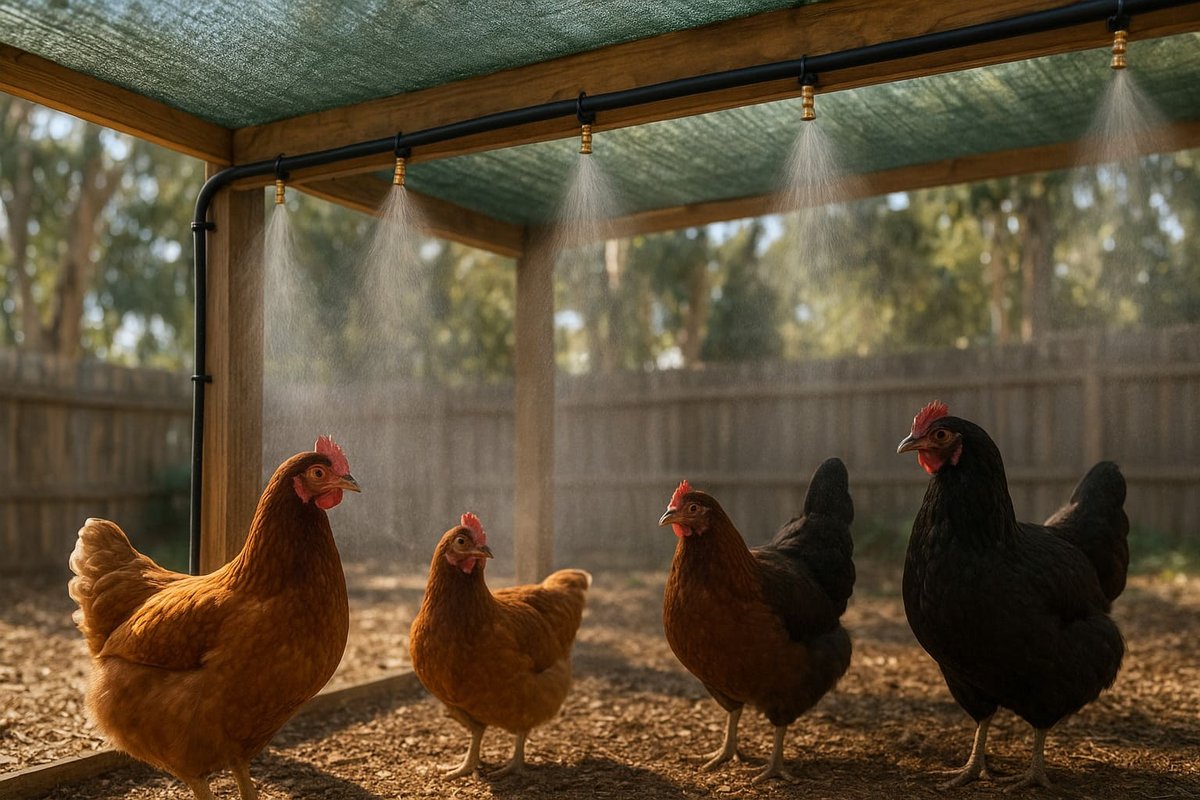
![Best Shade Cloth for Chicken Runs Australia 2025 [Complete Guide]](https://chickenstarter.com/wp-content/uploads/2025/11/Best-Shade-Cloth-for-Chicken-Runs-Australia-2025-Complete-Guide-1-300x164.jpg)
